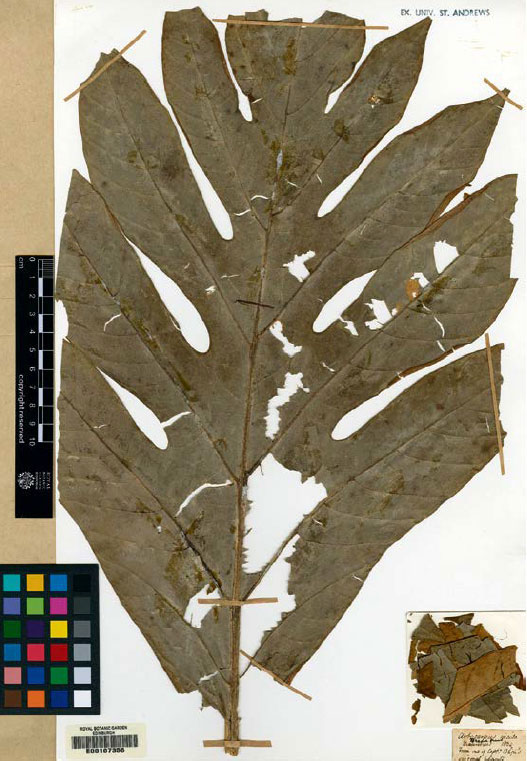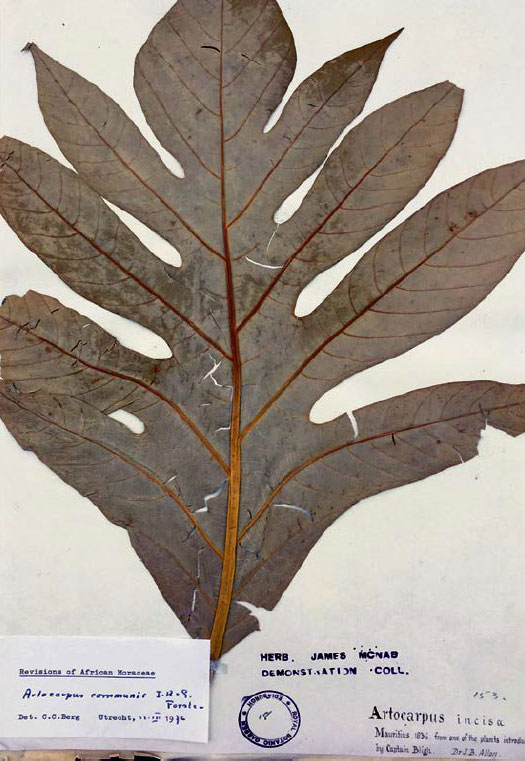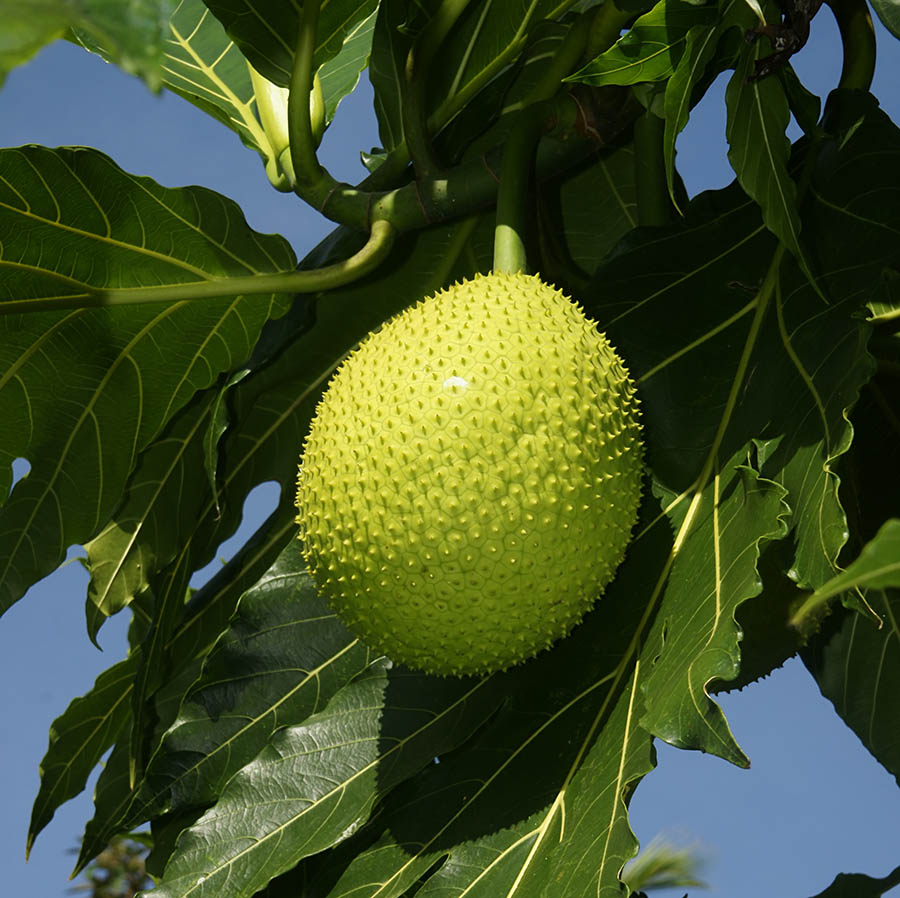Captain Bligh’s Breadfruit? Tall Tales about Two Leaves in Nineteenth-Century Edinburgh
Of the many thousands of dull brown leaves stored in the herbarium (dried plant collection) of the Royal Botanic Garden, Edinburgh (RBGE), two apparently have a special history. Once growing on breadfruit trees on the Indian Ocean island of Mauritius, these two leaves were picked and pressed in the nineteenth century and taken to Scotland [Figs. 1-2]. A note attached to each states that the original plants were introduced to Mauritius by one Captain William Bligh, a man notorious – in British culture at least – as the subject of one of the most serious mutinies in British naval history. But was this really the case?
Reading plants
At first glance, herbarium specimens do not appear to lend themselves readily to historical analysis. Purposefully decontextualized by their scientific creators, the two-dimensional specimen sheet reduces information to the key points required for botanical classification. Of the two specimens considered here, handwritten annotations state that the first leaf was collected in 1834 and the second two years later, in 1836, both from Mauritius (Figs. 3-4). Further notes record their botanical names according to Linnaean binomial nomenclature. 1 The stamped texts – ‘Ex. Univ. St. Andrews’ (1834) and ‘Herb. James McNab Demonstration Collection’ (1836) – indicate that the specimens were part of other Scottish collections before their accession to the main herbarium of the Royal Botanic Garden, Edinburgh.
From this, we can begin to infer some details about the geographical journeys that the two leaf specimens are likely to have taken: By the 1830s, the Indian Ocean island of Mauritius was a British colony and was well connected by sea transport to mainland Britain. The person who collected the 1836 leaf is even named on the sheet – one Dr J.B. Allan. He was, we presume, either resident in or visiting Mauritius; he probably also enjoyed a connection with the Scottish universities and botanical gardens that eventually received these specimens.
Breadfruits in British culture
Breadfruit (Artocarpus altilis [Parkinson] Fosberg) is a flowering tree from the mulberry and jackfruit family (Moraceae). It is relatively well known in the tropical parts of the world where it grows, but today few people in chilly Britain have heard of the plant. Yet, in the years around 1800, this tropical plant was the subject of immense public attention.
The final annotations on each sheet gesture toward that public interest. The two leaves were apparently taken ‘from one of Capt[ai]n Bligh’s original plants’ (1834) and ‘from one of the plants introduced by Captain Bligh’ (1836). Commander of the ship HMS Bounty, William Bligh (1754–1817) was tasked in 1787 with obtaining a large consignment of breadfruit plants from Tahiti and then transporting them round the world to the islands of St Vincent and Jamaica in the Caribbean, where they were to be introduced as foodstuffs for enslaved peoples.
Bligh’s breadfruit transplantation mission was the most ambitious of such projects of its time. Transporting live plants by sea was tremendously challenging due to the length of time away from land, the unpredictable and often hostile conditions that ships were exposed to, and the limited resources available aboard – particularly the lack of fresh water. No one had ever before attempted to move living plants quite so far in one go. But the economic potential of the breadfruit was huge: the plant was believed to be the solution to the pressing problem of how to provide enough food for the enslaved labourers on Britain’s colonial plantations.
Bligh’s mission, however, ended in disaster. In 1789 the crew of the Bounty mutinied, set him and eighteen other men adrift in a longboat deep within the Pacific Ocean, and threw the tiresome cargo of breadfruit trees overboard. Miraculously, Bligh and all but one of his men survived (the saplings did not). Although the tale of the mutiny is still relatively well known in British culture, few people are aware that the Bounty’s mission was to transport breadfruit plants.
Few people are also aware that Bligh accepted a second breadfruit commission shortly after his return to Britain. From 1791–92, he returned to Tahiti aboard HMS Providence, collected over 2000 live breadfruit plants, and sailed westwards from there across the Indian Ocean to the Caribbean, thus fulfilling the original brief. As a result of this mission, breadfruit was successfully introduced into the British Caribbean. Although initially rejected by the people enslaved there, it is now celebrated as a key part of Caribbean food culture.

Fig. 1: Artocarpusaltilis (Parkinson) Fosberg. Collected in Mauritius in 1834. Image reproduced with the permission of the Royal Botanic Garden Edinburgh (https://data.rbge.org.uk/herb/E00107356).

Fig. 2: Artocarpus incisus (Thunb.) L.f. / Artocarpus communis (J.R. Forst. & G. Forst.). Collected in Mauritius in 1836. Royal Botanic Garden Edinburgh (https://data.rbge.org.uk/herb/E01462864). (Photo taken by Sarah Easterby-Smith, March 2019)
Perhaps understandably, given the breadfruit’s associations with a swashbuckling history of deception and derring-do, many British popular histories that are purportedly about the plant actually focus ad nauseum on the story of William Bligh and the Bounty. They generally downplay the plant’s connections with colonisation and slavery, and they also overlook the significant place that the breadfruit occupies within Oceanian and Caribbean culture. This is the received history of the breadfruit, and one with which, thanks to the annotations on the sheets, these two specimens have been explicitly associated for almost two hundred years. But further investigation into their provenance reveals that the claimed association with Bligh might, in fact, not have existed at all.
Pacific histories
Researching provenance, when the subjects are plants, first involves a spot of botany. The ancestors of all breadfruit plants originated in New Guinea – an island that is over 7000 kilometres to the west of Tahiti. Gradual human migration across Oceania over thousands of years meant that, by the eighteenth century, breadfruit was widespread across, and appeared endemic to, the entire region. 2 But transporting breadfruit over long distances is very challenging: in botanical terms, the plant’s seeds are recalcitrant, which means that they will not grow unless planted within a specific time period after ripening. As breadfruit seeds cannot be stored for long, the only way to transport the plant over distance is through propagation, which resulted in the gradual creation of hundreds of cultivars (cultivated varieties) that are now distributed very widely indeed. One of the most significant consequences of that selective breeding has been a reduction of seeds within the fruit of some cultivars. In sum, the further away from the breadfruit’s point of origin in New Guinea, the fewer the number of seeds to be found in the fruit of each cultivar. Tracing cultivar distribution is now a highly instructive means of identifying the past migration routes taken by humans. 3

Fig. 3: Detail of Figure 1, showing the label appended to Artocarpus altilis (Parkinson) Fosberg. (E00107356).
And the breadfruit was high up on the packing list of every Oceanian traveller – for the plant and its products have an almost unrivalled ability to provide for, and even to protect, humankind. The fruit can be eaten (raw or cooked), and it can also be preserved in a handy paste for travelling. It can be used as animal fodder and fishing bait. Its wood makes excellent timber, firewood, and musical instruments, and the tree’s inner bark can be turned into cloth. Its sap can be used as a glue, as a means of waterproofing or caulking boats, as a base for dyes and even as a chewing gum. Its leaves can be used as sandpaper, plates, food wraps, fans, and kites. When burned, the male flowers act as a mosquito repellent, and the sap, shoots, roots, bark, and flowers can each be used in a wide range of different medicinal remedies. 4 In sum, the prolifically growing breadfruit has been, and still is, a holistic provider for humans.
Given this outstanding array of properties, it is perhaps not surprising that, across Oceania, the breadfruit has been associated with a spiritual force and is talked of as a divine gift linking the human and spiritual worlds. Tahitian origin stories, for example, tell of how, during a famine, a desperate father sacrificed himself to the gods in return for food for his family. The food that was sent – growing wondrously out of his grave – was Tahiti’s first ever breadfruit tree. 5
Moving forward to the eighteenth century, such tales are unlikely to have received much credance from the sailors who accompanied William Bligh. And they certainly don’t feature among the annotations on the herbarium specimen sheets. Nevertheless, the claimed association with Bligh suggests that the breadfruit in fact continued to inspire new narratives wherever it travelled.
Breadfruit narratives
The unfortunate Bounty never reached the Indian Ocean, and its leafy cargo was thrown overboard. Thus, the plants from which the two leaves shown here were plucked must have been conveyed by the Providence. According to the logs kept by Bligh and other crewmembers, Tahitian breadfruit plants were laded aboard in June 1792, and the ship set sail shortly afterwards. But from this point onwards, the narratives told about them diverge significantly from the available evidence about the geographical journey taken by these two specimens.
The addition of William Bligh’s name to these Mauritian specimens suggests that the Providence either stopped off at Mauritius en route or that Bligh sent the breadfruit to the island at a later date. Island stopovers were normal for ships taking long-distance journeys, allowing them to undertake repairs and to lade fresh provisions. Indeed, the presence of over 2000 live plants aboard placed additional pressures on the voyage because of their need for fresh water. A visit to Mauritius in 1792, however, would have been a rather surprising choice for Bligh because the island was a possession of Britain’s main colonial rival, France, with whom Britain had been formally at war since April of that year. Indeed, the official instructions issued to the Providence directed it to call at Madagascar, if need be, and not at the Mascarene islands. 6

Fig. 4: Detail of Figure 2, showing the annotations on Artocarpus incisus (Thunb.) L.f. (E01462864).
The log of the Providence clearly shows that the plants and people aboard were all in robust health as they traversed the Indian Ocean; the ship stopped neither at Mauritius nor at Madagascar and instead continued onwards to the British-held Atlantic Ocean island of St Helena. 7 Given that revolutionary France was Britain’s declared enemy in 1792, it is also extremely unlikely that Bligh – a naval commander – would have even considered gifting specimens to the French agronomists on Mauritius. Although the annotations on the specimen sheets assert that the Mauritian breadfruit was derived from Bligh’s plants, this cannot have been the case.
Mauritius passed from French to British control in 1810. Genetic analysis of the breadfruit trees now growing on the island, paired with archival research, has revealed that Mauritius received at least three introductions of breadfruit cultivars during the eighteenth century. 8 It is not clear, however, which cultivar or cultivars are represented by the RBGE specimens. What is clear, however, is that the addition of Bligh’s name to the specimen sheets is a falsehood. We do not know whether it was Dr J.B. Allan, or the specimens’ Scottish recipients, who added the annotations. Either way, claiming an association with Bligh and his renowned mission would have elevated the cultural capital associated with the specimens, enhancing their desirability as collectable items.

Fig. 5: Breadfruit at Tortuguero, Costa Rica. (Photo courtesy of Wikimedia Commons user Hans Hillewaert and reprinted under Creative Commons license, 2009)
For almost 200 years, then, Scottish botanists have believed that these specimens originated from William Bligh’s celebrated plant transfer mission. In fact, they may have had no connection to the Providence’s consignment of plants whatsoever. The claim made on the specimen sheets about the association with Bligh is a historical fiction, and one that speaks volumes about the cultural significance of Bligh’s story both to early nineteenth-century British colonists on Mauritius, and to the botanists and historians who subsequently did not question the purported association.
Tall tales
The format and presentation of the RBGE specimens asserts the authority of Western science. The placement of each leaf on a blank white background focuses the viewer’s attention on those objects only; the annotations further suggest that this information is all that is needed for our understanding of the plant. Anything else, we are asked to assume, must be irrelevant. Indeed, the authority commanded by Western science invites us to view the information on these herbarium sheets as fact; Oceanian breadfruit stories are relegated to a lower realm of “traditional” knowledge and – perhaps worse of all – myth-making and make-believe.
Archives, including herbaria, encourage us to consider the objects held within them in terms of the practices and processes of collecting: nomenclature and classification, geographical routes and scholarly networks. Those processes mirror the structure of the archive themselves. And yet when viewed from an Oceanian perspective, questions relating to collecting networks or taxonomy matter very little, and only at the moments of interaction with Europeans.
Instead, the breadfruit’s multiple histories speak to very different matters. In Oceania, the breadfruit’s ability to nourish, protect, and serve the human body leads it to be associated with a spiritual force. Even European science, despite its pretentions to objective abstraction, has not been immune to the cultural power of the breadfruit – as the fallacious claim to an association between the RBGE specimens and William Bligh shows very clearly. Wherever we find breadfruit, then, we find human connections. Those connections are manifested not only in the physical existence of the plants and the botanical specimens created from them, but also in the narratives told about them. Myth-making about the breadfruit has been as strong within British history as it has been in that of Oceania. 9
Sarah Easterby-Smith is a senior lecturer in modern history at the University of St Andrews, Scotland. A social and cultural historian of science, especially botany, her work focuses on French, British, and global histories of the eighteenth century. Much of her research has focused on how access to cultures of knowledge was permitted and constrained, and on the research potential offered by material culture. Email: ses22@st-andrews.ac.uk